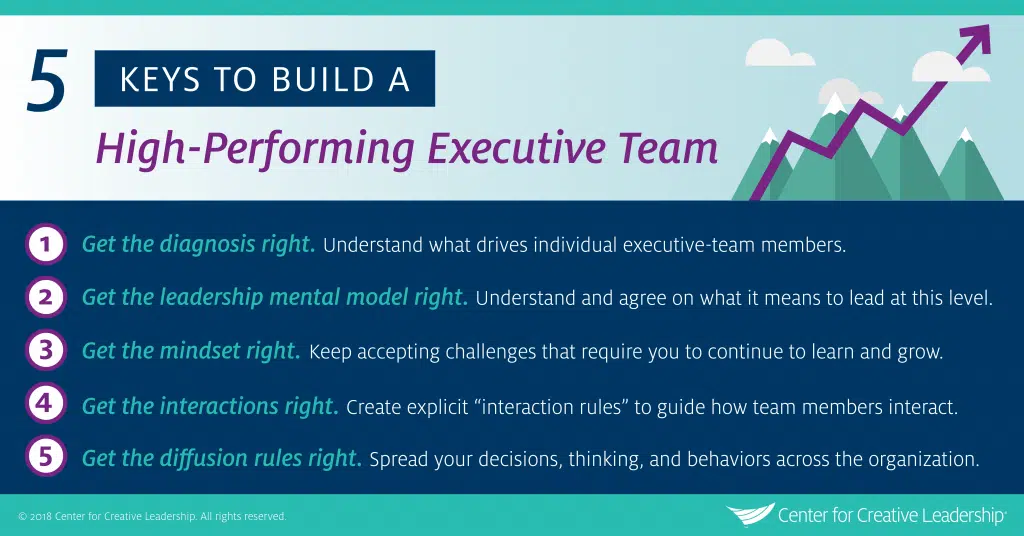When the senior team works well together, the whole organization functions better. Follow these 5 steps to build a high-performing executive team.
Executive teams play 2 critical roles in an organization.
The first is obvious: They provide strategic and operational leadership to the company. They set goals, develop strategies, and ensure the strategies are executed effectively.
The second is less obvious but just as important. The executive team provides the organizational and cultural DNA for the company. How well the executive team functions as a collective leadership body, and how its members interact, serve as the model that teams throughout the organization will follow.
The Impact of Increased Executive Team Effectiveness
You could fill entire libraries with the books and studies written about strategy and operations. But the second role of the executive team gets less press. Because it receives relatively little attention, executive team effectiveness can be the basis of significant competitive advantage for companies that get it right.
In our recent survey of senior executives, 65% indicated their executive teams were experiencing a clash between functional and enterprise accountabilities. But fewer than 1 in 5 rated their executive teams as “very effective.”
In the same survey, nearly all executives agreed that increasing the effectiveness of their executive team would have a positive impact on organizational results.
In other words, when the executive team functions better, the whole organization functions better.
The Best Executive Teams Have These 3 Things
3 Vital Threads
The best executive teams are characterized by 3 vital threads that run through everything they do:
1. Strategic focus.
Effective executive teams establish a vision for the organization and invest considerable time and energy at the strategic level. They balance risk and innovation, anticipate future needs and opportunities, and seek to ensure the organization’s sustainability.
2. Collective approach.
Top-performing executive teams work together, taking an enterprise-wide view of their individual and team functions. They model for the entire organization ways to break down silos and develop solutions to business problems together. Individuals on top-performing executive teams prioritize the interests of the organization over individual gains.
3. Team interaction.
Finally, the best executive teams are intentional in their interactions. They value their differences, listen and communicate well, seek input from each other, and trust and respect one another. These behaviors make teams more effective. Crucially, they also model for the rest of the enterprise what team interactions should look like.
5 Keys to Building a Highly Effective Executive Team
Part of every CEO’s job description should be to “build and develop a world-class executive team.” This is challenging because the qualities that typically earn senior executives a place on the executive team are necessary, but not sufficient, for peak performance on that team.
So how does one build a highly effective executive team? There are 5 keys:
How to Build a High-Performing Executive Team
1. Get the diagnosis right.
Situational awareness is a must-have for every individual, team, and organization. Your leadership team members should be masters of this skill, starting with their awareness of the executive team itself. That also goes for the CEO. An organization’s top leader needs to understand what motivates members of the executive team, and also what makes them work — or not — as a group.
2. Get the leadership mental model right.
Senior executives bring their preferences, past experiences, and biases to their roles. But leadership team roles require them to lead well beyond the circle of their personal influence, and do so in a way that’s coherent with overall organizational culture and strategy. A high-performing leadership team understands and establishes explicit agreement on what it means to lead at the enterprise level.
3. Get the mindset right.
For seasoned leaders, the executive team shouldn’t represent the summit of their professional development, but rather a new challenge that requires them to continue to learn and grow. They must also bring this perspective to their direct reports and others with whom they interact, encouraging them to develop beyond their technical expertise. A high-performing leadership team has a shared growth mindset.
4. Get the interactions right.
Creating explicit “interaction rules” to guide how team members interact with one another is critical to building effective teams. These interaction rules have to transcend cultural, functional, and circumstantial variations and become the “relational DNA” that drives professional interaction throughout the organization. Members of the executive team must be transparent, vulnerable, and comfortable learning in public; they must also have strong communication skills.
5. Get the diffusion rules right.
Finally, executive teams are only effective when their decisions, thinking, and behaviors can spread and amplify quickly across large numbers of people at all levels of the organization — to processes, projects, and places where they aren’t personally present. This ensures that strong, healthy executive team actions and values can be modeled by other teams throughout the enterprise.
You may be wondering whether your organization is getting all the value it can out of your executive team. In Are You Getting the Best Out of Your Executive Team?, we share research-based recommendations on how to increase executive team effectiveness and tools to evaluate and improve executive team performance.
Ready to Take the Next Step?
Build your executive team effectiveness, drive change, and execute strategy across the business. Partner with us for executive team development to assess the effectiveness of your executive team and help them work more cohesively and effectively, manage complexity and change, and lead the organization to achieve what matters most.










